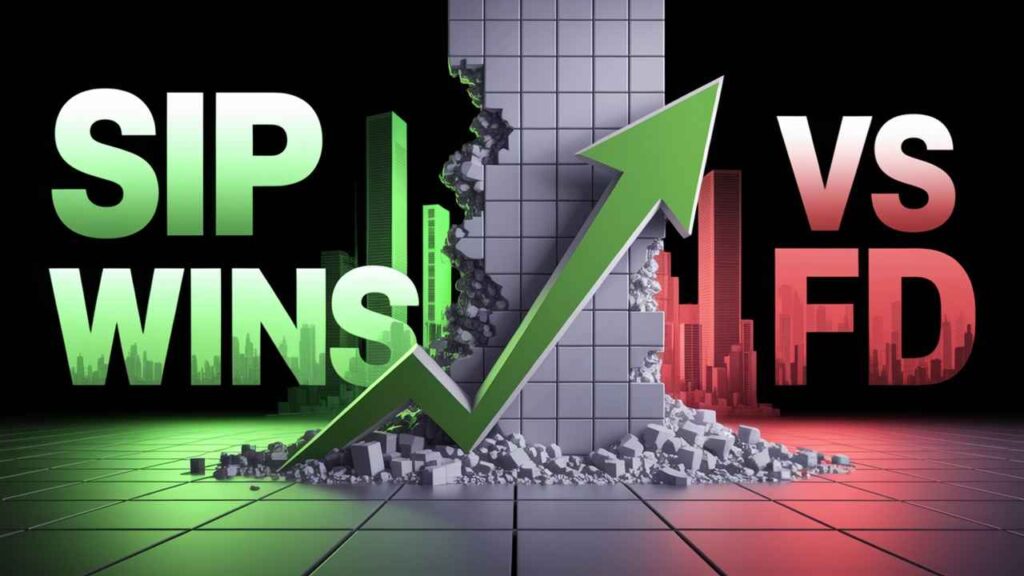SIP vs FD in 2025: Why SIP Wins in the Long Term
In 2025, many people are searching for safe and smart ways to increase their wealth. Systematic Investment Plans (SIPs) and Fixed Deposits (FDs) are popular choices.
SIPs are a method of consistently making small investments in mutual funds that can increase in value over time, depending on market performance. FDS, on the other hand, are fixed-return options that banks offer.
Investors are comparing SIP and FD closely because they want to know SIP or FD, which is better and will help them reach their financial objectives, provide greater safety and offer better returns.
In this blog, we will be comparing both the Best investment optionn in 2025 from real-world examples, up-to-date data and facts.
What is SIP?
If you are thinking of SIP or FD, which is better, then SIP is more suited for long-term goals and wealth creation. A SIP is a way to invest a fixed amount of money in mutual funds at regular intervals, like monthly or quarterly..
There are different types of mutual funds used in SIPS, like debt funds (for safety), equity funds (for high growth) and hybrid funds (a combination of both).
What is FD (Fixed Deposit)?
You can save money by making a lump sum deposit with a bank or other financial institution for a fixed time with an FD (fixed deposit). A guaranteed interest rate is given to you in exchange. The longer the term, the higher the interest.
FDs are a popular choice because they come in various forms, including standard bank FDs, tax-saving FDs (which have a five-year lock-in) and senior citizen FDs (which have higher interest rates).
Key Comparison Factors (SIP vs FD)
SIP and FD are two popular ways to save money and the Best investment option in 2025. In the given table, we have compared the factors like features, risk and returns.
| Factor | SIP (Systematic Investment Plan) | FD (Fixed Deposit) |
|---|---|---|
| Returns in 2025 | 10%–14% (average, market-dependent) | 6%–8% (fixed and guaranteed by the bank) |
| Risk Factor | Moderate to high (depends on market performance) | Very low (almost no risk) |
| Liquidity | High (can withdraw anytime, though may incur exit load) | Medium to low (penalty on premature withdrawal) |
| Taxation | Capital gains tax applies; LTCG after 1 year is taxed at 10% above Rs 1 lakh | Interest is taxed as per the income slab |
| Investment Flexibility | Very flexible; start with as low as Rs 500/month and increase anytime | Fixed amount for fixed tenure; no flexibility once invested |
| Long-Term Growth Potential | High (equity-linked growth and compounding over time) | Low (returns are fixed, no compounding beyond fixed rate) |
SIP Performance in the Last 5 Years
India’s mutual funds, particularly those offered through SIPs, have performed well between 2020 and 2024. Annual returns from equity mutual funds ranged from 14% to 16% on average, depending on the fund type.
Even better results were obtained by certain infrastructure and small-cap funds, which provided returns of more than 30% annually. This period also saw stable growth in the Sensex and Nifty, indicating support for long-term equity investing.
SIPs helped investors stay invested during market ups and downs. Due to this, SIP has been a smart and reliable investment option for the past five years.
The majority of Indian banks are providing regular investors with FD interest rates ranging from 6% to 7% in 2025. The percentage for senior citizens may rise slightly from 7% to 7.75% to 8%. Even though FDs are regarded as safe, it’s important to understand how inflation impacts your real income. If you’re thinking long term, you may ask: Which is better, SIP or FD, for 10 years?
The rising price of goods and services is known as inflation. If inflation is around 6%, and your FD gives 7%, the real return is only 1%. That’s the extra value your money earns after covering the increase in prices. Additionally, the final return is further decreased by the fact that interest earned on FDs is taxable.
FDs are low-risk investments, but their returns, especially after taxes, may not always beat inflation. Before you put all of your money into FDs, it’s important to take this into account.
Also Read: Best Investment Options for College Students in India
Why SIP is Better Than FD in the Long Term
SIP returns vs FD returns clearly show why SIP in mutual funds is often better than FD for long-term goals. This is due to the possibility that SIPs, particularly in equity mutual funds, could offer larger returns.
SIPs in quality equity funds can offer 10% to 15% or more over time, whereas FDS offer fixed returns (roughly 6% to 7%).
Most significantly, SIPs help you beat inflation, something that FDs might not do. Regular investing and the power of compounding help build wealth for 10 to 15 years. Therefore, for long-term investors, SIP is a better option.
When FD Might Still Be a Better Option
Some circumstances may make FDs a better option. Because FDS offer fixed returns and are unaffected by market fluctuations, they are safer if you have a short-term objective such as purchasing something within six months or a year. Because of this, FDs can be considered the best investment option in 2025.
For safety, short-term plans and emergencies, FDs are a better choice than SIP even though SIP is better for long-term growth.
Real-Life Examples
Let’s take an example, suppose you invest Rs 5000 per month for ten years.
- An FD with a 7% annual interest rate, your total investment will be of Rs 60,0000. Approximately Rs 8.59 lakhs will be the total amount. You get about Rs 7.87 lakhs after paying 20% interest.
- In a SIP giving a 12% average return yearly, your investment grows to around Rs 11.62 lakhs. After 10% tax on gains (above Rs 1 lakh), your final amount will be around Rs 11.30 lakhs.
Over ten years, SIP provides approximately Rs 3.4 lakh more than FD. This shows that SIP is a better option for the long term since it increases your income through higher returns and lower taxes.
Also Read: Top Health Insurance Tips to Consider Before Buying a Policy in Delhi
Final Verdict
Though they have different uses, both SIP and FD are the best investment options in 2025. For the creation of long-term wealth, SIP is the best choice.
It provides tax advantages, higher returns and inflation protection. SIP can help you increase your money more quickly over five to ten years or longer by using the power of compounding and consistent investing.
On the other hand, FD works well for short-term objectives, emergency savings and the elderly and other people who prefer zero risk. Though the returns are typically lower, it offers fixed and secure returns.
FAQS Section (for SEO)
1. Is SIP better than FD in 2025?
Yes, it can help beat inflation and offer larger returns than an FD. Compounding and tax benefits make SIP a good choice for building wealth.
2. Can I lose money in SIP?
Yes, SIP carries a risk of loss. Because mutual funds are correlated with the stock market, their returns may fluctuate.
3. What are the risks of FD?
Although FDS carries very little risk, their returns are also lower. The largest danger is that the returns might not outpace inflation.
4. What is the safest investment option in India?
Government bonds, Post Office schemes, Bank FDS and Public Provident Funds (PPF) are the safest choices.
5. Which is better, SIP or FD, for 10 years?
SIP is better than FD for ten years. Inflation can be beaten, returns are higher, and it is more tax-efficient. Over time, SIP increases wealth as well.
FD is only better for short-term or low-risk needs because it is safer, but yields less.





